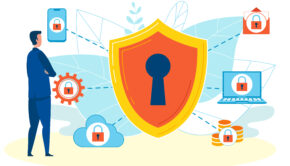How To Prepare A Business For Challenges Of Industry 4.0
Over the past three centuries, we have witnessed more progress than our forefathers did over the past two millennia. In the middle of the eighteenth century, the industrial revolution changed humanity forever, giving us steam engines, railroads, and the ability to bend the earth to our will.
After that, it wasn’t long before the second industrial revolution arrived on the scene and brought with it mass production, leading to our modern-day consumer society.
Subsequently, as humankind was leaving one millennium and preparing for a new one, Industry 3.0 came on the scene. With it, robots and automated processes made their way into our factories, increasing our production, lowering our costs, and keeping us safer in the process.
Today, we are on the eve of a new industrial revolution, one that promises to weld our physical world with our virtual one. The fourth industrial revolution, or Industry 4.0 as it is known, will increase both our efficiency and productivity. It will generate more revenue for existing companies as well as new revenue streams for companies that are yet to be built, and it will lead to the creation of new business models, the likes of which we have never seen.
But, like any revolution, Industry 4.0 is bound to bring plenty of challenges with it, and if companies don’t prepare for them, they will be subsumed by the competition. So, to prepare better, here are some of the challenges bound to sprout up and how companies can face them:
Challenges that come with Industry 4.0
#1. Security
The first challenge most companies will face is that of data security. Before Industry 4.0, companies stored most of their data on an internal server or computer, which represented a single repository that could be protected from malicious outside attacks.
But, things will change once companies start using smart technology, connecting it all to the internet, and uploading a large portion of their data to the cloud.
This will mean that there are several vulnerable points of attack, and these potential leaks must be sealed tight. Otherwise, not only are companies going to risk their reputation and bottom line, but they also might have their intellectual property stolen by one of their competitors, putting them out of business.
How to deal with it
Ideally, there should be laws in place that protect a company’s data from being stolen, regardless of how that data was generated or where it was started. Yet, seeing as the law has always lagged behind technology, most companies will have to fend for themselves till the law catches up.
The good news is that there are plenty of things companies could do today to protect themselves. To start with, an organization should be aware of all of their vulnerabilities, something they could achieve by keeping an inventory of all of their digital assets and monitoring their network.
Then, companies would do well to have a security system in place, such as an authentication process, for all their digital assets, no matter how small or on-the-periphery the asset may seem.
Despite all these precautions, companies should also prepare for the worst. They should always monitor their network and work hard to detect suspicious activities. And, in the event of a cyberattack, companies need to have contingency plans in place to bounce back quickly.
#2. Standardization
At the moment, one of the main challenges facing the Internet of Things, also known as IoT, is the lack of standardization. The problem is that different technologies may rely on different systems, making communication between them difficult.
Until a standard system is put in place, any company investing in this space is taking a risk because the system they are using might end up becoming obsolete in a few years.
How to deal with it
Concerning the standardization problem, most organizations will have to take a risk and bet on the software that they believe will lead the industry. Nevertheless, if things go south, companies can try to reach out to their technology partners in the hopes of developing software that will enable cross-platform operation.
#3. Network misconfiguration
Another problem pertains to network configurations. A misconfigured network will result in several unstable links, commands that never arrive at their intended terminal, and an unreliable network that may harm the company’s bottom line.
How to deal with it:
When it comes to network misconfigurations, it’s hard for companies to know that they have a problem until something happens. In other words, rather than working hard at eradicating all misconfigurations out of the gate, most companies should assume that some network issues are bound to happen, and they should work hard to spot them as early as possible.
This means that companies ought to keep an eye on their entire network, taking stock of all of their assets as well as all of the communication going on in said network. Vigilance is key here.
#4. Skills gap
With all of the technology arriving with Industry 4.0, some companies might have a hard time keeping up.
For one, there is bound to be a shortage of skilled labor that knows how to work with artificial intelligence, blockchain technology, and cloud technology. Additionally, an aging workforce might mean that most people will not only be unused to these new developments but will also struggle to adapt to them.
How to deal with it
There are several ways of overcoming this problem.
Firstly, even though several technical specialties will be in demand, this doesn’t mean that soft skills will be forgotten; if anything, they will be more important than ever as the value of good customer service will also rise.
Secondly, companies should put in place training programs to bring their workforce up to speed. These training programs should encourage lifelong learning, relay new concepts through hands-on experience, and help employees hone their skills as they become more proficient.
At the end of the day, companies want to balance between training their current workforce and bringing in new blood.
Getting ready for tomorrow
As Industry 4.0 is changing the world, companies can either adapt or go the way of the dinosaurs. But, unlike dinosaurs, companies have the ability to see how the industrial tides might be changing and prepare for this climatic shift and the challenges it brings with it.









![How can Parents Sustain Healthy Relations with Their Teens [Infographic]](https://technofaq.org/wp-content/uploads/2016/07/ig_HEAder-150x150.jpg)





